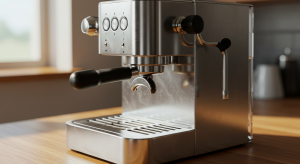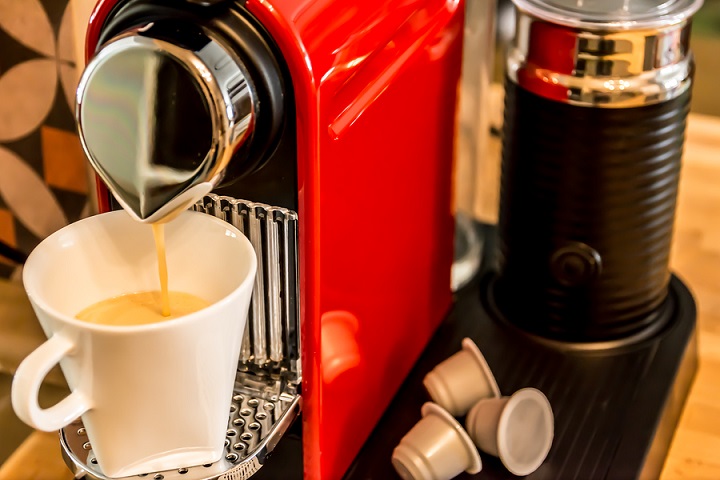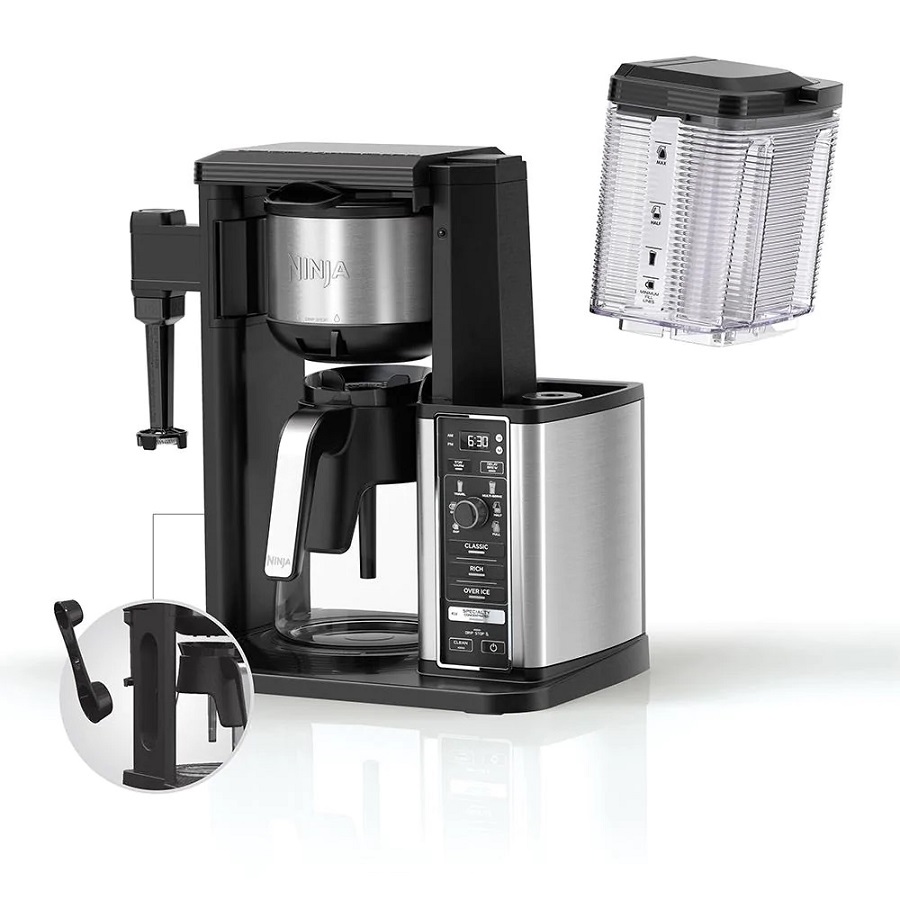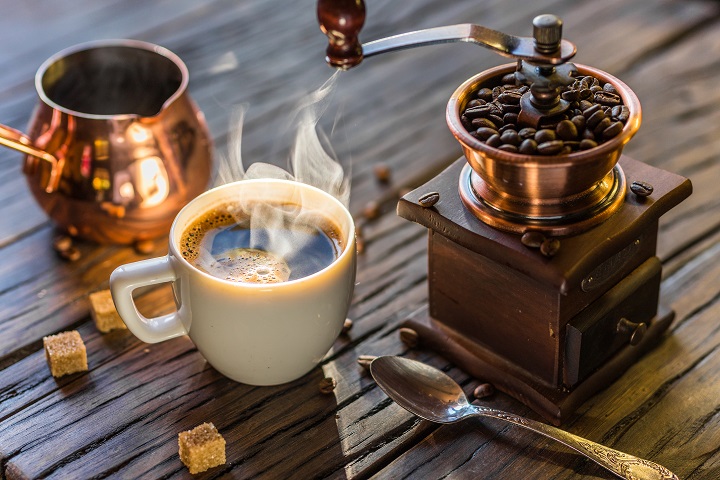French press coffee has an irresistible charm. It’s rich, full-bodied, and almost effortless to prepare. Yet, getting it right requires more than just dumping coffee grounds into hot water. In this guide, we’ll explore the best French press technique to help you brew a perfect cup every time. We’ll also walk through useful tips, common pitfalls, and handy formulas you can trust.
What We'll Cover
- Understanding the French Press
- Preparing Your French Press
- Step-by-Step French Press Technique
- Bonus: Coffee Ratio & Steep Time Table
- Troubleshooting Common French Press Issues
- People Also Asked
- Can I use pre-ground coffee in a French press?
- Why do I need to let the coffee bloom?
- How do I clean a French press?
- Comparing French Press to Other Brewing Methods
- Conclusion
Understanding the French Press

The French press, also called a press pot or plunger pot, is a manual coffee maker invented in the mid-19th century. It has a simple design—a glass or stainless-steel cylinder, a metal mesh filter, and a plunger. Its simplicity gives you direct control over steeping time and water temperature.

GET MORE CAPACITY: The 32-ounce ESPRO French press holds 48 ounces of water and brews 32 ounces of delicious coffee. This top-tier coffee maker features a stainless steel with double filter, ensuri...
According to the National Coffee Association, water temperature is critical for extracting coffee’s most desirable flavors. This level of control sets the French press apart from drip machines or single-serve pods.
Key Advantages of a French Press:
- Full Flavor Extraction: The metal filter allows essential oils to pass through.
- Environmentally Friendly: No disposable paper filters are needed.
- Customizable Brewing: You can adjust the coffee-to-water ratio or steep time.
Preparing Your French Press
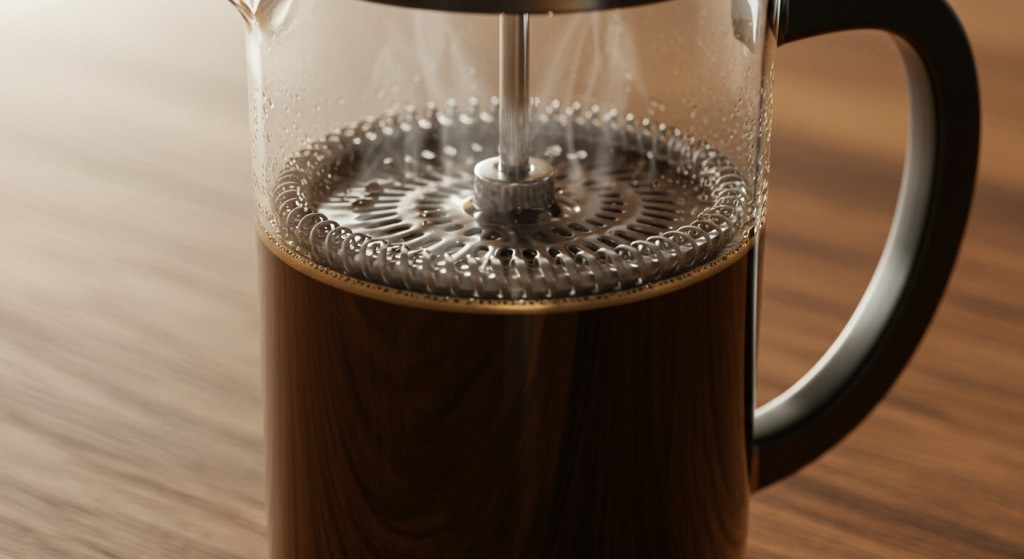
1. Gather Your Equipment
- French Press: Make sure the plunger and mesh filter are intact.
- Freshly Roasted Coffee Beans: Aim for medium-dark or dark roast if you prefer a bold taste.
- Burr Grinder: Provides a consistent coarse grind size.
- Kettle or Pot: For heating water.
- Scale or Measuring Spoon: Ensures consistent ratios.
- Thermometer (Optional): Helps you gauge water temperature precisely.
2. Grind Your Coffee
A coarse grind is essential. If the coffee is too fine, it clogs the filter and causes over-extraction, resulting in a bitter flavor. If it’s too coarse, you might end up with a weak, watery taste.
- Ideal Grind Size: Roughly the texture of coarse sea salt.
- Rule of Thumb: Grind just before brewing to lock in freshness.
3. Heat the Water
Heat fresh, filtered water to about 195°F–205°F (90°C–96°C). This range is recommended by the National Coffee Association for optimal extraction. If you don’t have a thermometer, simply boil water and let it sit for 30 seconds to 1 minute before pouring.
Pro Tip: Pre-warm your French press by rinsing it with hot water. This stabilizes the brewing temperature.
Step-by-Step French Press Technique
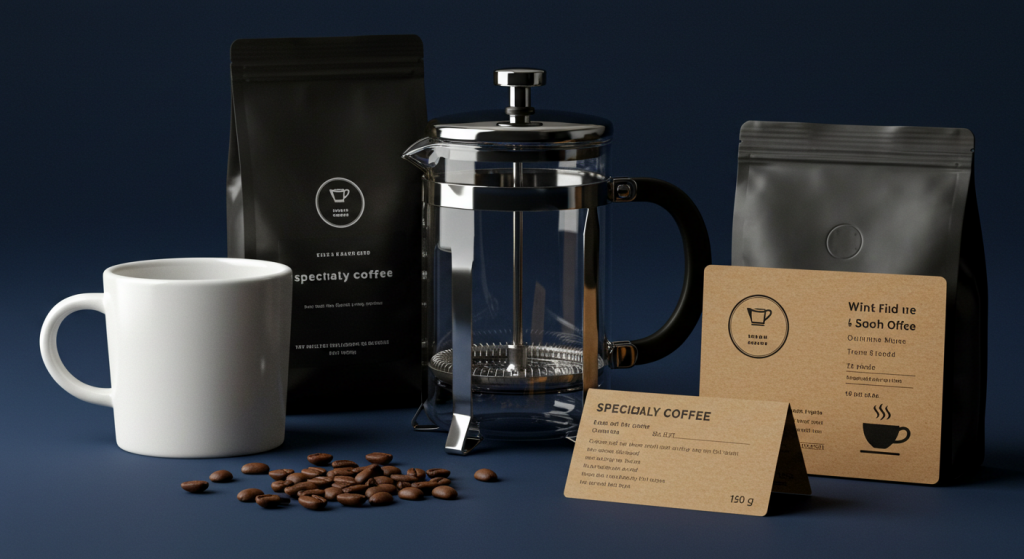
Below is the best French press technique step by step. Follow these instructions to achieve a well-balanced, aromatic cup of coffee.
-
Measure the Coffee and Water
- A standard ratio often recommended is 1:15—that is, 1 gram of coffee per 15 grams of water.
- Alternatively, for an 8-ounce (about 237 ml) mug, you might use 15 grams of coffee and 225 ml of water.
- Use a scale for precision or measure out approximately 2 tablespoons of coffee for every 6 ounces (177 ml) of water.
-
Bloom the Coffee
- Add the ground coffee to the French press.
- Pour in just enough hot water to saturate the grounds.
- Let it sit for about 30 seconds. This initial pour, called the “bloom,” releases carbon dioxide and preps the coffee for an even extraction.
-
Fill and Stir
- After blooming, pour the remaining hot water into the French press.
- Stir gently to ensure all grounds are immersed in the water. A quick swirl with a wooden spoon helps maintain the optimal steeping temperature.
-
Steep for 4 Minutes
- Place the plunger lid on top but don’t push it down yet.
- Allow the coffee to steep for about 4 minutes for a full-bodied flavor. If you prefer a bolder taste, consider extending this to 5 minutes.
-
Plunge Slowly
- Press the plunger down with gentle, steady pressure.
- If you push too hard or quickly, the coffee grounds can escape around the filter or you risk spillage.
- A slow plunge ensures the coffee’s oils and flavors remain in the brew.
-
Serve Immediately
- Transfer the coffee to cups or a carafe to avoid over-extraction.
- Leaving coffee in the French press with the grounds can make it bitter.
Why This Technique Works:
- A balanced coffee-to-water ratio ensures a proper extraction without bitterness.
- Proper steep time allows flavor compounds and essential oils to infuse into the water.
- Slow plunging keeps the grounds contained, giving you a smoother cup with minimal sediment.
Bonus: Coffee Ratio & Steep Time Table
Below is a quick-reference table to help you dial in your coffee-to-water ratio and steep time.
| Cup Size (Fluid Oz) | Coffee (Grams) | Water (ml) | Steep Time (Minutes) |
|---|---|---|---|
| 8 | 15–16 | ~225 | 4–5 |
| 12 | 22–24 | ~340 | 4–5 |
| 16 | 30–32 | ~475 | 4–5 |
Use this as a starting point. Feel free to adjust the ratio for a stronger or milder brew.
Troubleshooting Common French Press Issues
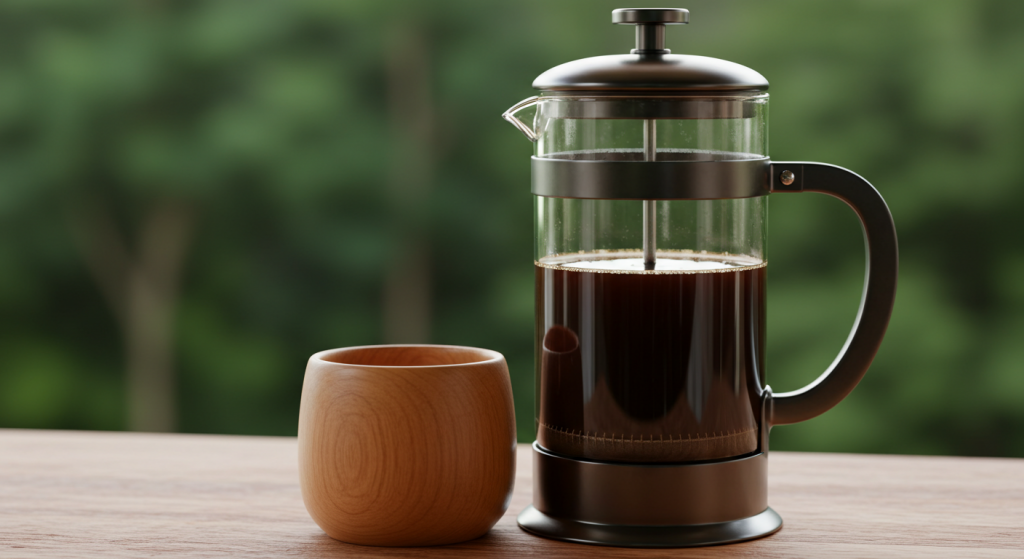
1. Bitter Coffee
- Problem: Over-extraction often leads to bitterness.
- Solution: Reduce your steep time by 30–60 seconds or use a slightly coarser grind.
2. Weak or Watery Coffee
- Problem: Under-extraction or using too few grounds.
- Solution: Increase the steep time to 5 minutes or add more coffee.
3. Gritty Texture
- Problem: Filter mesh may be worn, or grind is too fine.
- Solution: Use a coarser grind and check if you need a replacement filter.
People Also Asked
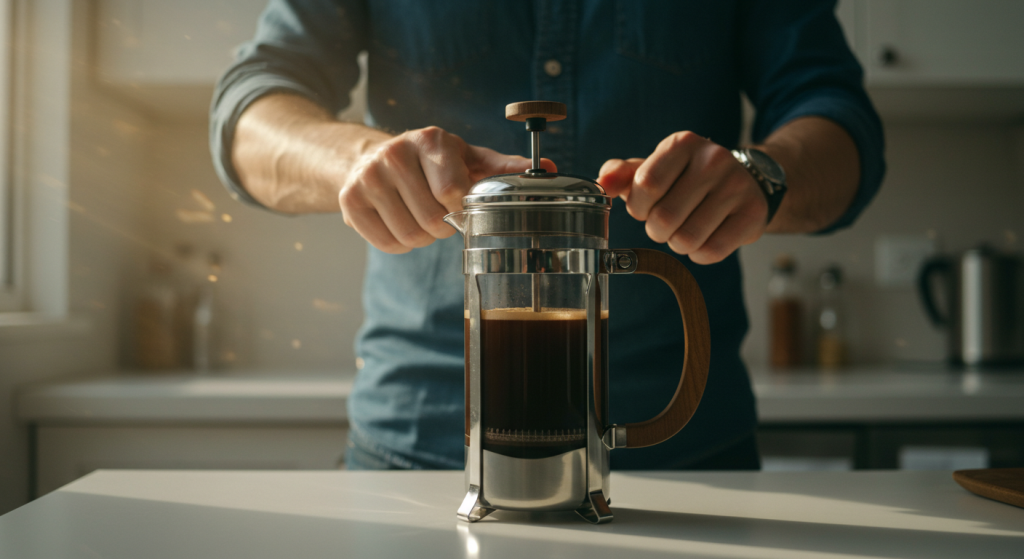
Can I use pre-ground coffee in a French press?
Yes, you can, but fresh, coarse-ground coffee yields the best taste. Pre-ground coffee often has a finer grind intended for drip machines, which can result in over-extraction and sediment.
Why do I need to let the coffee bloom?
Blooming releases trapped gases in freshly roasted coffee. By letting it bloom, you ensure even saturation, which leads to a more balanced flavor profile.
How do I clean a French press?
Disassemble the plunger and rinse away used grounds. Use warm water and mild soap if needed. Ensure all parts are fully dry before reassembling to prevent mildew or odors.
Comparing French Press to Other Brewing Methods
1. Drip Coffee
- Pros: Convenient and quick.
- Cons: Paper filters can trap flavorful oils.
- Takeaway: If you want a more robust flavor and control over steep time, the French press is better.
2. Pour-Over
- Pros: Clean, bright flavor; precise extraction.
- Cons: Requires practice and specialized gear (filter, gooseneck kettle).
- Takeaway: Pour-over can be meticulous. If you want a simpler, full-bodied result, the French press wins.
3. Espresso Machine
- Pros: Strong, concentrated coffee; short brew time.
- Cons: Expensive and complex to operate.
- Takeaway: Espresso is different in taste and consistency. It’s not a direct substitute for French press coffee.
Conclusion
Mastering the best French press technique isn’t complicated. The key is balancing the coffee-to-water ratio, controlling the water temperature, and choosing the right grind. The beauty of the French press lies in its simplicity and flexibility. Whether you like a robust flavor or something more delicate, you can adjust variables until you find your perfect cup.
In summary, remember to:
- Use freshly roasted, coarse-ground coffee.
- Bloom the coffee for 30 seconds.
- Steep for about 4 minutes.
- Plunge slowly and serve immediately.
By following these steps, you’ll enjoy a satisfying, full-bodied coffee every time. So heat the kettle, grind the beans, and relish your next French press brew.
With practice, you’ll refine your French press technique and savor the kind of rich, aromatic coffee that coffee shops charge top dollar for—right in the comfort of your own home.
The responses below are not provided, commissioned, reviewed, approved, or otherwise endorsed by any financial entity or advertiser. It is not the advertiser’s responsibility to ensure all posts and/or questions are answered.


